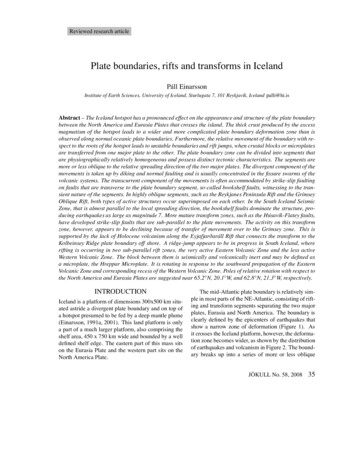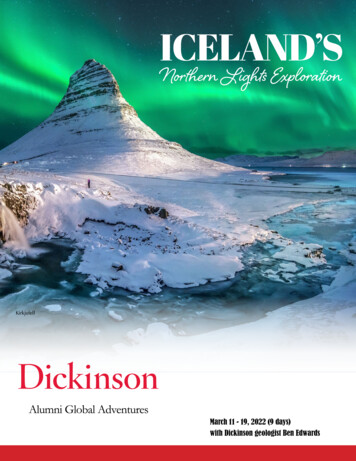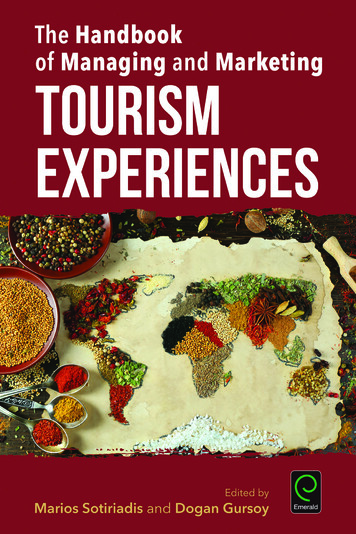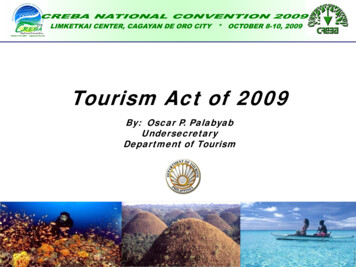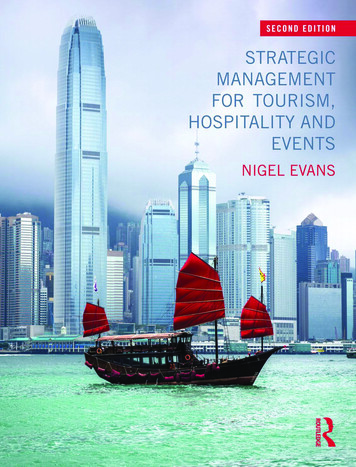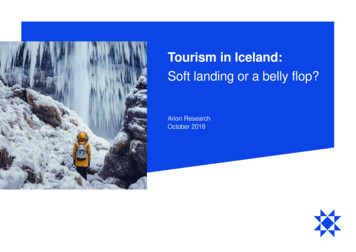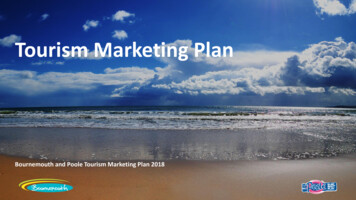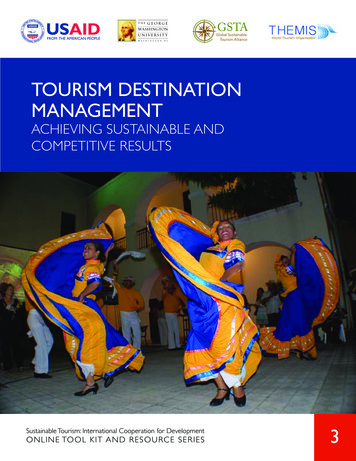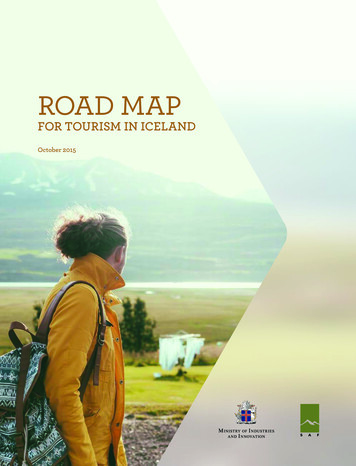
Transcription
ROAD MAPFOR TOURISM IN ICELANDOctober 2015
SUMMARYOver the past years, the rise in the number of tourists visiting Iceland has far exceeded forecasts andthe sector is expected to continue to grow. In orderto support the successful development of tourism inIceland, the minister of Industries and Commerce, whois also the minister of Tourism, and the Icelandic TravelIndustry Association joined forces to shape a long-termtourism strategy with an emphasis on sustainabledevelopment. A steering group and working groupwas established to collect data, analyse the situationand acquaint themselves with models from abroad. Inaddition to this, meetings were held with over 1,000people throughout the country.laying solid foundations for the successful and sustainable future development of the tourism industry. Overthe next five years, the emphasis will primarily beplaced on tasks that support:Major opportunitiesTourism Task ForceA great deal is at stake, since tourism and its development entail great opportunities for the community toincrease prosperity and positive regional development.Tourism has played a major role in Iceland’s economicgrowth in recent years and, at the same time,generated thousands of new jobs. Foreign exchangeearnings from this sector as a whole are expected tosubstantially increase, rising from ISK 350 billion in2015 to more than ISK 620 billion in 2020 and probablyover ISK 1,000 billion by 2030. These are extremely highfigures, considering that the country’s total currencyinflows are expected to reach ISK 1,140 billion in 2015.On the basis of an agreement made between theIcelandic government, the Icelandic Association ofLocal Authorities, and the Icelandic Travel IndustryAssociation (SAF), a Tourism Task Force will be set upand operate until the end of 2020. The Tourism TaskForce will ensure that the next five years are usedto tackle the tasks that are required to lay the solidfoundations that are needed in the Icelandic tourismindustry. Its function is to coordinate measures andfind solutions in collaboration with government administrations and municipalities, as well as the supportframework for this sector throughout the country, thesector itself and other interested parties.Need to bolster foundationsWork on strategy development soon revealed theweakness of existing foundations for the formation of afuture tourism strategy in Iceland. Reliable and internationally comparable data and yardsticks are urgentlyneeded, responsibilities are in many cases uncertain,the legal framework is complex, and the organisationof the sector is unclear. The conclusion of the steeringgroup was therefore to focus particularly on prioritytasks over the next five years, since they are aimed atÂÂCoordinated management of tourismÂÂPositive visitor experienceÂÂReliable dataÂÂNature conservationÂÂSkills and qualityÂÂIncreased profitabilityÂÂBetter distribution of touristsSound foundationsGreat opportunities lie ahead and it is vital to tapthem correctly. With more systematic management,integrated approaches, professional solutions, investment in infrastructure and joined forces, the tourismindustry can continue to thrive on sound foundations ingood harmony with the community, environment andother sectors of the economy.
GROWTH IN TOURISMAccording to the United Nations World Tourism Organization (UNWTO), there were over 1.1 billion touristsaround the globe in 2014. About half of them visited countries in Europe, i.e. 580 million, some 70 million ofwhom travelled to Northern Europe and approximately a million to Iceland. The tourists who visited Icelandtherefore accounted for 0.2% of the tourists who travelled to Europe and 1.4% of those who travelled toNorthern Europe.For many years now the increase in the number of tourists visiting Iceland has greatly exceededtrends elsewhere in the world. The international media coverage Iceland has been receiving,increase in the supply of flights and exchange rate developments, combined with effectivemarketing and other interrelated factors have resulted in an average year-on-year increase of22% in the number of foreign tourists over the past five years, a growth rate that is five timesgreater than in the rest of the world.The United Nations World Tourism Organization expects the rise in the number of tourists to continue at a global level, forecasting 1.4 billion in 2020 and 1.8 billion in 2030.The annual increase in tourism in Iceland is expected to continue to exceed globaltrends, due to, among other things, a growing enthusiasm for winter, outdoor andadventure tourism and a thriving interest in Iceland in general.Tourism has been the principal driving force behindeconomic growth in Iceland since 2011 and generated8,000 new jobs in its core sectors. The sustained growth inthis industry presents opportunities to enhance prosperityand positive regional development in Iceland.The country’s foreign exchange earnings from tourism as awhole in 2015 have been estimated at ISK 350 billion1. All goingwell, this sector will yield over ISK 620 billion in foreign exchangeearnings in 2020 and over ISK 1,000 billion in 2030. These aresubstantial figures, since by comparison the currency inflows for theeconomy as a whole in 2015 are estimated at ISK 1,140 billion.1 This is taking into account foreign tourists in Iceland and the activity of Icelandic tourism companies abroad.
THANKS TO PARTICIPANTSThe drafting of this Road Map for Tourism was based on a broad search,both domestically and abroad, and over 1,000 people were involved inthis project. Data was evaluated, the state of the tourism industry wasanalysed and the experiences of other nations, such as New Zealand,Scotland, Australia and Canada, which have been at the forefrontof developments in tourism, were taken into account. Mostimportant of all, though, was the participation from the public,government, municipalities, state institutions, companies intourism, associations, financial undertakings, membersof parliament, academics and the university community.Over 50 meetings were held all around the country anda broad consensus was reached on the prioritiesidentified by those who attended the meetings. Allthese people are thanked for their invaluablecontributions.Collaboration betweenthe ministry and the sectorIn order to support the successful developmentof tourism in Iceland, the minister of Industries andCommerce, who is also the minister of Tourism, and theIcelandic Travel Industry Association joined forces to shapea long-term tourism strategy with an emphasis on sustainable development.The steering group comprised the minister of Industries andCommerce, Ragnheiður Elín Árnadóttir (Chairperson), the directorand chairman of the Icelandic Travel Industry Association (SAF),Grímur Sæmundsen, the managing director of SAF, Helga Árnadóttir,and director general of the Icelandic Tourist Board, Ólöf Ýrr Atladóttir.The working group comprised consultants Guðfinna S. Bjarnadóttir andVilhjálmur Kristjánsson from LC Lead Consulting, Helga Haraldsdóttir andBrynhildur Pálmarsdóttir from the ministry of Industries and Innovation, HelenaKarlsdóttir from the Icelandic Tourist Board, as well as consultants ÞorgeirPálsson and Vilborg Helga Júlíusdóttir, who were nominated by the Icelandic TravelIndustry Association.Published by: Ministry of Industries and Innovation and the Icelandic Travel Industry AssociationTranslation: Brian FitzGibbonDesign and layout: Jónas Þorbergsson, FínlínaPhotos: Promote Iceland and ShutterstockPrint: Printed in Iceland by Prenttækni 2015, Ministry of Industries and Innovation
The working group’s meetings were heldthroughout the country and included the following:201410.11 Various interest groups12.12 Regional marketing offices201527.02 Open meeting in theEastern Region29.04 Open meeting in Höfnin Hornafjörður04.05 Icelandic Tourist Board22.01 Icelandic Tourist Board03.03 Open meeting inReykjanesbær22.01 Representatives from theIceland Tourism Cluster03.03 Representatives fromStatistics Iceland27.01 Representatives from theMinistry of the Interiorand its agencies10.03 Icelandic Travel IndustryAssociation27.01 Representatives from theMinistry for the Environmentand Natural Resourcesand its agencies11.03 Open meeting in Hólmavík15.05 Icelandic Travel IndustryAssociation12.03 Open meeting in Húsavík19.05 MPs from Independence party17.03 Open meeting in Borgarnes19.05 AGM of the Reykjavík CapitalArea Tourism Association08.01 Iceland Growth Forum19.01 Icelandic Travel IndustryAssociation29.01 Promote Iceland04.02 Various academics10.03 Open meeting in Akureyri17.03 Open meeting inGrundarfjörður05.02 Icelandic Tourism Association18.03 Companies in thetourism sector06.02 Various interest groupsin the economy23.03 Representatives from theThingvellir Committee06.02 Association of LocalAuthorities in Iceland25.03 Open meeting in Hvammstangi11.02 Representatives from traveland outdoor associations11.02 Representatives fromministries and municipalities18.02 Group from various publicentities and banks19.02 Icelandic Travel IndustryAssociation26.02 Insurance companies26.02 Representatives fromthe Ministry of Welfareand its agencies08.04 Open meeting on behalfof Visit Reykjavík09.04 Icelandic Tourism Council21.04 Prime Minister’sOffice and others21.04 Open meeting in Selfoss21.04 Meeting on accessmanagement andaccess issues24.04 Icelandic TourismResearch Centre28.04 Occupational Council06.05 Association of universityeducated tourism experts06.05 MPs from Left-GreenMovement13.05 MPs from Bright Future party20.05 Meet in Reykjavík27.05 Regional marketing offices04.06 Open meeting inPatreksfjörður12.06 Open meeting in Ísafjörður16.06 MPs from SocialDemocratic Alliance19.08 Ministry for the Environmentand Natural Resourcesand ministerial staff03.09 Representatives fromIcelandic Associationof Local Authorities14.09 Representatives fromMinistry of Finance andEconomic Affairs01.10 Representatives fromPrime Minister’s OfficeOctober 20153
COMPLEX REALITYTourism is, by its nature, broad ranging. Looking at the following graph2, which represents the current position ofthe sector, one can see that all ministries are involved with tourism in one way or another, and that the legal framework is complex. Responsibilities are in many cases uncertain and the organisation of the sector is unclear. There arenumerous other challenges posed by tourism, such as, among other things, environmental and social carrying capacity considerations, quality issues and various economic factors. The most important task that lies ahead is therefore tobolster the foundations for the further developmentof this sector, but this calls for integratedsolutions, prioritisation, and a great dealof harmonisation work for ministries,institutions and interest groups.2 This overview graph is by no means exhaustive and ispublished with the proviso that it may be subject to changes.Please send any comments to ferdamalastefna@anr.is4Road Map for Tourism in Iceland
October 20155
SOUND FOUNDATIONSThe conclusion of the steering group was that there wasa need to lay the foundations for the prosperous andsustainable development of tourism over the next fiveyears. These foundations are a prerequisite for theshaping of a long-term strategy. A new Tourism TaskForce will play a key role in this regard.Tourism Task Force 2015-2020The Tourism Task Force will operate until the end of2020. Its board is made up of ministers from the fourmain areas connected to the tourism industry, aswell as four representatives from the sector andtwo representatives from local municipalities. TheTourism Task Force will ensure that the next fiveyears are used to tackle the tasks required to laythe solid foundations that are needed in the Icelandictourism industry. Its function is to coordinate measures and find solutions in collaboration with governmentadministrations, municipalities, the support frameworkfor this sector throughout the country, the sector itself andother interested parties.Reforms in the sectorThe Road Map for Tourism emphasises the following seven keyelements: coordination, providing a positive visitor experience, reliable data, nature conservation, skills and quality, increased profitabilityand a better distribution of tourists.This is clearly an immense task since it entails, among other things, theintegration and simplification of the administrative system, financing of infrastructures, nature conservation, professional development of the sector, qualitycontrol and coordinated measures – and all of this calls for the involvement ofeveryone engaged in the tourism industry. For this purpose, the Government ofIceland, the Icelandic Travel Industry Association and the Icelandic Association ofLocal Authorities have made an agreement to bolster the Icelandic tourism industryuntil the end of 2020.The objective is to lay sound foundations between 2015-2020, after which the focus willshift to securing that the framework of the sector is dynamically structured, which is crucialto enable the potential of the tourism industry to be fully tapped. In the long term, the goal isto ensure that tourism in Iceland becomes exemplary and to firmly establish the country as anattractive and sustainable destination for tourists in harmony with the landscape and its people.6Road Map for Tourism in Iceland
The coordination that is being proposed here will lead to an effective structuringof the tourism industry, infrastructure development, enhanced quality, theconservation of nature and heritage, as well as a better distribution of touriststhroughout the year and around the whole country. On this basis, tourism canevolve in harmony with the country and its people and tourists can benefit froma positive experience, characterised by hospitality and quality.Tasks of the next five yearsLong-term outlookThe next five years will be devotedto laying solid foundations to ensuretourism can continue to thrive on asound basis. A common trait sharedby many of the countries that haveexcelled the most in developing asuccessful and sustainable tourismindustry is the dynamic collaborationthey have fostered between ministriesand institutions to lay solid foundationssuch as those presented here.If properly handled, the tourism industry will become a sustainable andprofitable sector for the future, which yields stable foreign exchangeearnings to the economy and increases prosperity and the quality of life inIceland. The outlook for the future is bright and comprises the following:The tasks that lie ahead are complexand multifaceted and prioritiestherefore have to be clearly establishedevery step of the way. At the sametime, there is a great need for flexibilitysince the sector is rapidly evolving.The Tourism Task Force is thereforeexpected to evaluate the position of thesector before the drafting of the budgetevery year between 2016-2020. In thewake of this, the prioritisation of tasksshall be reviewed and a project andfinancial plan shall be submitted foreach coming year.ÂÂÂÂÂÂÂÂA general consensus has beenreached on the importanceof tourism as a pillar of theeconomy.Decision making in the tourismindustry is based on timely,reliable and internationallycomparable data.Nature is the main attractiondriving the Icelandic tourismindustry and systematic effortsare made to conserve it, guidedby the principles of stresscontrol and sustainability.Tourism in Iceland ischaracterised by high skilllevels, quality, harmony and agood reputation.ÂÂÂÂÂÂÂÂÂÂTourists recommend Iceland andexperience unique hospitality,high quality standards, goodservice and adventure on theirtravels.The tourism industry is aprofitable sector of the economywhich attracts a skilled workforce.Transport evolves in line with therise in the number of tourists.The tourism industry has beenboosted throughout the countryin good harmony with thepopulation, environment andworkers in the sector.A coordinated administrationworks efficiently with the sectorto achieve results; collaborationyields results.October 20157
OBJECTIVES AND YARDSTICKSReliable data is essentialThere is a real shortage of timely, reliable and internationally comparable data ontourism in Iceland to use as a basis for decision-making and setting objectives. Thecompilation of reliable statistics in the tourism industry is a complex process, butthere are good precedents in, among other places, Australia and New Zealand,where ways of making good use of reliable data and ensuring ongoing measurements of the state of the sector are being developed. This creates theconditions for establishing realistic targets and the appropriate follow-up toguarantee results.The plan is to take into account the experience and know-how ofcountries that are at the forefront in this field and ensure that clearobjectives and measurements of the state of the sector are in placeat each point in time. This is a prerequisite for achieving results.Here are the objectives and key yardsticks that will be focusedon to evaluate the results and benefits of the sector. Theprincipal objectives are: to provide a positive visitor experience, increase profitability, broaden the distribution oftourists and a positive attitude towards the sector. Eachobjective has its own key yardsticks, but because of the shortage of reliable data, no numerical values have been establishedon this occasion. The plan is to make the collection of data apriority in 2016. This will provide the basic criteria required to setnumerical targets and to subsequently follow them up.Positive visitor experienceThe recommendation score of tourists measures high in comparisonwith other countries3.ÂÂThe percentage of foreign tourists who have visited Iceland beforeincreases (return rate).ÂÂIncreased profitabilityÂÂÂÂÂÂAdded value in tourism increasingly contributes to the GDP.Increase in foreign exchange earnings from foreign tourists per overnight stay.Increase in labour productivity.Wider distribution of touristsÂÂA higher percentage of tourists visit Iceland in the off-peak season.A higher percentage of overnight stays by foreign guests in hotels and guest houses in rural areaswill be generated outside the peak season (June-August). Measurable growth targets will be set foreach region, based on the situation in each region.ÂÂPositive attitude towards the sectorÂÂÂÂ8The attitude of Icelanders towards tourism measures positive.The job satisfaction rate in the sector measures high.Road Map for Tourism in Iceland3 The aim is to measure the so-called Net Promoter Score (NPS), which is a recognised andinternationally comparable tool for measuring satisfaction and positive visitor experience.
WORK PLAN PRIORITIESFOR 2016-2017Priorities shall be reviewed by theTourism Task Force every yearÂÂ Master the rapid growth in the sector withthe Tourism Task Force, which coordinates measures and ensures priorities areimplemented.ÂÂ Ensure that reliable, timely and internation-ally comparable measurements provide aclear picture of the sector at any given time.ÂÂ Set measurable objectives based on reliabledata and follow them up to achieve the bestresults.ÂÂ Work on branding Iceland as a destination,define target groups and market accordingly.ÂÂ Find solutions to ensure municipalities havesufficient revenue to meet their costs in thedevelopment and management of touristdestinations under their jurisdiction.ÂÂ Ensure that the national transport plantakes into account the needs of the tourismindustry and the projected rise in the number of tourists.ÂÂ Ensure that the maintenance and develop-ment of air travel infrastructures are in linewith the rise in the number of tourists in thecountry.ÂÂ Increase the safety of tourists and pre-vention through, among other things,harmonised information and signpostingthroughout the country.ÂÂ Make effective Destination ManagementPlans (DMPs) for every region in the country.ÂÂ Select “model sites” that are known assuch, both in Iceland and abroad, and startwith the selection and design in 2016.ÂÂ Take tourist destinations into account in theorganisation of municipalities and prioritisethem in every region with an emphasis ondeveloping facilities for tourists.ÂÂ Decide which tourist destinations in eachregion require access management andmanage traffic around them, taking intoaccount environmental and social carryingcapacity concerns, guided by the principlesof tourist safety.ÂÂ Define requirements for integrated solutionsto support skills, quality, professionalismand know-how in the tourism industry andwork on effective ways to improve them.ÂÂ Make plans regarding the manpower andtraining needs in the tourism industry ineach region.ÂÂ Establish effective risk management basedon continuous risk assessment in line withthe best models abroad.ÂÂ Boost the tourism department in theMinistry of Industries and Innovation.ÂÂ Systematically find ways to eradicate theblack market in the sector.ÂÂ Further simplify the regulatory frameworkin tourism and introduce a single portalfor the issuance of licenses and supportdocuments.October 20159
TOURISM TASK FORCETemporary project in 2015-2020 to establish a firm foundationBoardThe function of the Tourism Task Force is to coordinate measures and findsolutions in collaboration with government administrations, municipalities, the support framework for the sector throughout the country,the sector itself and other interested parties. The Prime Ministerappoints its board. The minister of Industries and Commerce,who is also the minister of Tourism is the chairperson. Theminister of Finance and Economic Affairs, the minister for theEnvironment and Natural Resources and the minister of theInterior shall also sit on the board along with four representatives from the Icelandic Travel Industry Associationand two representatives from the Icelandic Associationof Local Authorities.The Tourism Task Force will ensure that the nextfive years are used to take on the tasks that arerequired to lay the solid foundations that areneeded in the Icelandic tourism industry, by amongother things, supporting the funding of measuresand coordinating development work.Managing DirectorThe Tourism Task Force will follow the Road Map forTourism and appoint a managing director who will draw talentfrom Iceland and abroad to address the most pressing prioritiesin the tourism industry in Iceland.The Althing is expected to be annually briefed on the status of tourism projects, along with emphases and priorities for the future.BoardManaging d Map for Tourism in IcelandNatureConservationReliable DataIncreasedProfitabilitySkills andQualityDistributionof Tourists
SEVEN FOCAL POINTS IN THE ACTIVITIESOF THE TOURISM TASK FORCE IN 2015-2020pages12-13pagesCoordinationPositive Visitor Experience14-15pages16-17pagesReliable DataNature Conservation18-19pages20-21pagesSkills and QualityIncreased Profitability22-23pages24-25Distribution of TouristsOctober 201511
COORDINATIONCoordination and a holistic approach is crucial forlaying a firm foundation in the tourism industryCoordination consensusTo ensure optimal operating conditions and the success of the Icelandic tourismindustry in harmony with the country and its people, a cross-ministerial approach is needed for effective coordination with an integral vision and sharedresponsibility. Under an agreement between the Icelandic government, theIcelandic Travel Industry Association, and the Icelandic Association ofLocal Authorities for the strengthening of the Icelandic tourism industry, which was signed in October 2015, the Tourism Task Force willcoordinate the forces of the government, the tourism industry andmunicipalities to implement the Road Map for Tourism.More efficient administrationAdministration will be simplified and its effectivenessincreased in order to simplify the management of tourismentities by, among other things, coordinating institutions,streamlining work procedures, simplifying and harmonising legislation and regulations and setting up a singleportal for the issuance of licenses and support documents.Tourism will also be given more weight within the Ministryof Industries and Innovation and the role of the TourismDepartment will be better defined in relation to, among otherthings, policy-making, the harmonisation of the legal framework,funding and the enhancement of the working environment in thesector.Tourism Task Force 2015-2020The Tourism Task Force shall appoint a managing director to coordinatemeasures and follow up on the Road Map for Tourism. Among other things,care shall be taken to ensure that reliable data on the state of the sector arepublished on a regular basis, that the implementation of priority tasks is coordinated and objectives systematically followed up on. The managing director of theTourism Task Force shall seek the collaboration of others to define ways of achieving the best results. Close links will be fostered with the representatives of publicinstitutions that deal with tourism issues, as well as representatives from the industryand other interested parties. The Tourism Task Force shall draft proposals regarding theprioritisation of measures in connection with the budget every year, since this prioritisationis expected to be revised on a continuous basis.Risk managementThe main risk factors in the Icelandic tourism industry are expected to be evaluated on an ongoing basis. Examples of risk factors include natural disasters, environmental risks, black economyactivities, reputation, security issues, economic issues, the interaction between the sector and thegovernment, over-investment, information issues, breaches of the law etc.12Road Map for Tourism in Iceland
Measures for 2015-2020 and expected resultsMeasuresResp.Expected resultsAn agreement has been signed forthe creation of a Tourism Task Forcewhich combines the forces of thegovernment, Icelandic Associationof Local Authorities and IcelandicTravel Industry Association toimplement priority tasks and laysolid foundations for a successfuland sustainable tourism industry.PMOÂÂThe Tourism Task Force monitorsobjectives and priorities.TTFÂÂÂÂThe Tourism Department inthe Ministry of Industries andInnovation shall be strengthened andadministration shall be boosted.MIITTFÂÂÂÂEffective risk management shall beset in place, and tax evasion and blackmarket activities shall be monitored.MII Ministry of Industries and InnovationTTFPMO PM OfficeÂÂÂÂThe Tourism Task Force works according to an agreement whichreflects the integral vision, shared responsibilities, and inter-disciplinary obligations of public entities and the sector, which is designed toachieve concrete results in the Icelandic tourism industry.The Tourism Task Force is a forum for monitoring objectives and priorities in the tourism industry, but it can also respond to important issuesthat can arise and which need to be addressed in this rapidly growingsector and ever-changing circumstances.A clear set of priorities and work plan for the tourism industry needsto be in place at each point in time, as well as effective collaborationbetween public bodies, institutions and tourism entities.The Tourism Department in the ministry has been strengthened and itsfunction well defined with regard to, among other things, policy-making, the legal framework, funding and the enhancement of the workingenvironment in the sector.Efforts continue on enhancing administration by, among other things,simplifying legislation and regulations, coordinating work proceduresand setting up a single portal for the issuance of licenses and supportdocuments.Risk assessment is effective in the sector and monitored through riskmanagement.Black market activities have been substantially reduced in the tourismindustry.TTF Tourism Task ForceOctober 201513
POSITIVE VISITOREXPERIENCESatisfied tourists and a satisfied nationImplementation of the Road Map for Tourism in all regionsA key element is to focus on the development of tourism in the wholecountry by, among other things, making a Destination ManagementPlan for tourism in each region. The Tourism Task Force shall makeagreements for the implementation of the Road Map for Tourism,which companies and interested parties in each region cancontribute to and agree upon. The agreement shall place anemphasis on measures which support hospitality, qualityservice and a positive visitor experience. Special care shallbe taken to ensure the ongoing positive attitude of localstowards the sector through, among other things, activeconsultation.Information and communicationwith touristsEfforts will continue to identify ways of improvingthe provision of information to tourists throughout the country with an emphasis on electronicsolutions and signposting. Systematic efforts shallbe made to improve the provision of information witha special focus on finding ways to establish contact withtourists before they start their trips, when they arrive in thecountry and during the course of their stay.Safety of touristsSystematic efforts shall be made to evaluate ways of reducingaccidents and mishaps among domestic and foreign touristsand to increase their safety in collaboration with the police force,the Icelandic Association for Search and Rescue (ICE-SAR) and theIcelandic Travel Industry Association. A special emphasis shall be placedon systematic prevention work, which entails, among other things, definingthe risks, setting rules and safety restrictions and managing the access oftourists to sites where their safety may be considered to be at risk. Moreover,signposting and instructions shall be harmonised and shall be both in Icelandicand English and possibly other languages.14Road Map for Tourism in Iceland
Measures for 2015-2020 and expected resultsMeasuresResp.The Tourism Task Force and interestedparties in every region shall make anagreement for the implementationof the Road Map for Tourism with anemph
The tourists who visited Iceland therefore accounted for 0.2% of the tourists who travelled to Europe and 1.4% of those who travelled to Northern Europe. For many years now the increase in the number of tourists visiting Iceland has greatly exceeded trends elsewhere in the world. The international me
